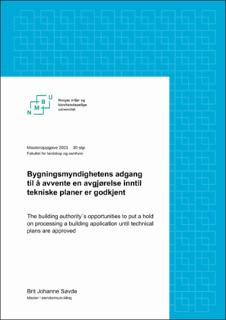| dc.contributor.advisor | Taubøll, Steinar | |
| dc.contributor.author | Søvde, Brit Johanne | |
| dc.coverage.spatial | Norway | en_US |
| dc.date.accessioned | 2021-12-03T09:41:45Z | |
| dc.date.available | 2021-12-03T09:41:45Z | |
| dc.date.issued | 2021 | |
| dc.identifier.uri | https://hdl.handle.net/11250/2832709 | |
| dc.description.abstract | Oppgaven omhandler kommunens muligheter til å holde tilbake en avgjørelse av en byggesøknad, inntil andre instanser har gitt sin aksept til utformingen av teknisk infrastruktur.
Teknisk infrastruktur er en grunnleggende forutsetning i utbyggingsprosjekter. Hvordan anleggene blir planlagt og utført, har stor samfunnsmessig betydning med tanke på sikkerhet, økonomi og utforming av omgivelsene. Flere faktorer, som befolkningsutvikling, endret bosettingsmønster, klimaendringer og utdaterte anlegg, øker behovet for utbygging og oppgradering av den tekniske infrastrukturen. Kommunen eier en stor del av den tekniske infrastrukturen, og vil sikre at det som bygges blir utført på best mulig måte.
Plan- og bygningsmyndighetene skal forvalte plan- og bygningsloven slik at rettssikkerheten blir ivaretatt. Krav om forenkling, effektivisering, større forutsigbarhet og kortere saksbehandlingstid har vært bakgrunnen for flere lovendringer, og er et aktuelt tema også i dag.
Gjennom kommune- og reguleringsplanlegging kan kommunen vedta planbestemmelser som er nødvendige for å ivareta spesielle hensyn og interesser, blant annet for teknisk infrastruktur. Planbestemmelsene må holde seg innenfor rammene som er fastlagt i loven, eksempelvis regler om saksbehandling og ansvars- og kontrollsystemet.
Regelverket er komplekst, det kan være fristende å ta snarveier. Det finnes ordninger mekanismer? i plan- og bygningsloven som gir kommunen åpning for å gå inn i detaljene. Mulighetene for kommunen som eier av teknisk infrastruktur, er knyttet til bruk av utbyggingsavtaler eller opparbeidingsplikten. I tillegg kan tilsyn benyttes. For bygningsmyndighetene er det få muligheter til å unnlate å avgjøre en byggesøknad, de som finnes er fastsatt i selve loven, gjennom samordningsplikten.
Avslutningsvis er det sett nærmere på eksempler som viser bruk av planbestemmelser i praksis, for å vurdere bruken opp mot funn i analysen av gjeldende rett. Det er gjort betraktninger rundt hva som skal til for at bygningsmyndighetene skal kunne holde tilbake en avgjørelse inntil kommunen, som eier av teknisk infrastruktur, har godkjent prosjektering og utførelse av tiltakene det er søkt om. | en_US |
| dc.description.abstract | This master thesis deals with a municipality’s opportunities to hold the decision of a building application, until other instances have given their design approval of technical infrastructure.
Technical infrastructure are basic needs which must be taken care of in development projects. How the facilities are designed and constructed have a huge, societal impacts regarding safety, economy, and design of the surroundings. More factors, like the population development, changed settlement pattern, climate changes and old technical facilities increase the need of building and upgrading the technical infrastructure. The municipality owns a large part of the technical infrastructure and want to ensure that what are going to be built will be done in the best possible way.
The planning- and building authority shall manage The Planning and Building Act in a way that takes care of the rule of law. Simplification, streamlining, greater predictability and shorter case processing time have been the reason of a lot of law changes, and it is still an overriding principle in the management of the law today.
It is possible to make planning provisions which are necessary to take care of special considerations and interests regarding technical infrastructure. Planning provisions must be kept inside the legal framework of the law, for example case processing rules and liability system.
The regulations are complex, and it can be tempting to take a shortcut. There are provisions in The Planning and Building Act giving the municipality opportunities to manage the details in a new construction project. The opportunities for the municipality as the owner of technical infrastructure are using development agreements or the rules that gives the rights to demand technical infrastructure. In addition, supervision can be used by the building authority. The building authority have few opportunities to put a hold on processing a building application, except what is already in the law.
Finally, the thesis has looked at how some real-life examples shows how the planning provisions are used and considered when analysing findings regarding the current law. There are also considerations about what needs to be done for the building authority to put a hold on a decision until the municipality has approved the design and construction of the technical infrastructure. | en_US |
| dc.language.iso | nob | en_US |
| dc.publisher | Norwegian University of Life Sciences, Ås | en_US |
| dc.rights | Attribution-NoDerivatives 4.0 Internasjonal | * |
| dc.rights.uri | http://creativecommons.org/licenses/by-nd/4.0/deed.no | * |
| dc.subject | Lov 27. juni 2008 nr. 71 om planlegging og byggesaksbehandling | en_US |
| dc.subject | Plan- og bygningsloven § 12-7 | en_US |
| dc.subject | Plan- og bygningsloven § 11-9 nr. 3 | en_US |
| dc.subject | Plan- og bygningsloven § 27-1 | en_US |
| dc.subject | Plan- og bygningsloven § 27-2 | en_US |
| dc.subject | Plan- og bygningsloven § 27-4 | en_US |
| dc.title | Bygningsmyndighetens adgang til å avvente en avgjørelse inntil tekniske planer er godkjent | en_US |
| dc.title.alternative | The building authority´s opportunities to put a hold on processing a building application until technical plans are approved | en_US |
| dc.type | Master thesis | en_US |
| dc.description.version | submittedVersion | en_US |
| dc.description.localcode | M-EUTV | en_US |

